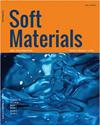The ensemble of immobilized superparamagnetic nanoparticles: the role of the spatial distribution in the sample
IF 1.4
4区 材料科学
Q4 MATERIALS SCIENCE, MULTIDISCIPLINARY
引用次数: 1
Abstract
ABSTRACT In this work, static, thermodynamic and magnetic properties of interacting superparamagnetic nanoparticles have been studied using theory and computer simulation. Two types of particles’ distributions in the sample have been considered: (a) at the nodes of the simple cubic lattice and (b) by the random way. It was assumed that the directions of the easy axes for all particles were parallel to each other and directed at an angle to the external magnetic field. The theoretical approach is based on the expanding of the Helmholtz free energy into the classical virial series up to the second virial coefficient. The analytical expressions of the Helmholtz free energy for both textures allow us to obtain theoretical predictions for the static magnetization and the isochoric heat capacity. These characteristics turned out in a good agreement with the Monte-Carlo simulation data in the broad range of considered system parameters. In a zero and moderate external magnetic fields, the new theory allows to describe the numerical calculations much more efficient than the ideal approximations, for which the interparticle dipole-dipole interactions were neglected.固定化超顺磁性纳米粒子系综:在样品中空间分布的作用
本文运用理论和计算机模拟的方法,研究了相互作用的超顺磁性纳米颗粒的静态、热力学和磁学性质。考虑了两种类型的粒子在样品中的分布:(a)在简单立方晶格的节点处和(b)通过随机方式。假设所有粒子的易轴方向彼此平行,并与外部磁场成一定角度。理论方法是基于将亥姆霍兹自由能扩展到经典维里级数,直到第二维里系数。两种纹理的亥姆霍兹自由能的解析表达式使我们能够获得静态磁化和等容热容的理论预测。在所考虑的系统参数的大范围内,这些特性与蒙特卡罗模拟数据非常一致。在零和中等外部磁场中,新理论可以比理想近似更有效地描述数值计算,而理想近似忽略了粒子间偶极-偶极相互作用。
本文章由计算机程序翻译,如有差异,请以英文原文为准。
求助全文
约1分钟内获得全文
求助全文
来源期刊

Soft Materials
工程技术-材料科学:综合
CiteScore
2.90
自引率
0.00%
发文量
21
审稿时长
2.2 months
期刊介绍:
Providing a common forum for all soft matter scientists, Soft Materials covers theory, simulation, and experimental research in this rapidly expanding and interdisciplinary field. As soft materials are often at the heart of modern technologies, soft matter science has implications and applications in many areas ranging from biology to engineering.
Unlike many journals which focus primarily on individual classes of materials or particular applications, Soft Materials draw on all physical, chemical, materials science, and biological aspects of soft matter. Featured topics include polymers, biomacromolecules, colloids, membranes, Langmuir-Blodgett films, liquid crystals, granular matter, soft interfaces, complex fluids, surfactants, gels, nanomaterials, self-organization, supramolecular science, molecular recognition, soft glasses, amphiphiles, foams, and active matter.
Truly international in scope, Soft Materials contains original research, invited reviews, in-depth technical tutorials, and book reviews.
 求助内容:
求助内容: 应助结果提醒方式:
应助结果提醒方式:


